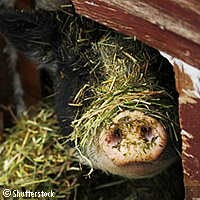Crunch time for wildlife infections control
Diseases transmitted from wild animals to humans have impacted the lives of many people over the years. But what measures are being taken to curb this ballooning headache? A group of EU-funded researchers is developing a pan-European surveillance system that would keep an eye on the infections that make their presence known in wildlife. Ultimately, both the public and livestock would benefit from this innovation. The WILDTECH ('Novel technologies for surveillance of emerging and re-emerging infections of wildlife') project received EUR 6 million in funding under the 'Food, agriculture and fisheries, and biotechnology' Theme of the EU's Seventh Framework Programme (FP7). Led by the University of Nottingham in the UK, the 13-member consortium says WILDTECH is getting down to business by building the tool that will help the health sector predict and manage disease threats from wildlife. The system will also evaluate the risk to humans and domestic animals. Latest data indicate that 61% of known pathogens are zoonotic (diseases that cross over from animals to humans). However, not enough information is available to help people better understand how prevalent these diseases are in wildlife. The project partners are also seeking to get a handle on how these diseases are transmitted to (and progress) in humans. 'Since a large proportion of pathogens can infect multiple animal species and can be passed from animal to human, it is not surprising that 75% of all diseases which have emerged in the last few years are of wildlife origin,' explained Professor Richard Lea of Nottingham's School of Veterinary Medicine and Science. 'Despite this alarming situation, surveillance for infectious disease is far from satisfactory,' he added. 'Climate change, deforestation, pollution, pathogen evolution and the rapid global movement of people, animals and animal products have all put humans at increasing risk of major epidemiological shifts in existing zoonotic diseases in wildlife and emerging new ones.' For her part, Dr Lisa Yon, Lecturer at the University of Nottingham, said: 'There is no doubt that a unified multi-country strategy is needed to combat the increased threat of new and emerging pathogens to animal and human well-being. We need to be aware of every potential threat - from the recent emergence of diseases such as avian influenza and swine flu to the changing distribution of bluetongue virus.' The 12 European WILDTECH partners come from Croatia, France, Germany, Greece, Netherlands, Sweden and the UK, and include academic and industrial partners. They are joined by one international partner - the University of Saskatchewan in Canada. The WILDTECH project kicked off in July 2009 and will end in 2012. The partners have also initiated collaboration with the World Organisation for Animal Health and government agencies. The aim is for the system to make a global impact. 'The key to success of this important project is the development of rapid and accurate diagnostic systems, which are both novel and can be applied to a wide range of diseases and host animal species,' said Professor Duncan Hannant of Sterilizer Validation & Monitoring Specialists in the UK, a WILDTECH partner.
Countries
Canada, Germany, Greece, France, Croatia, Netherlands, Sweden, United Kingdom



